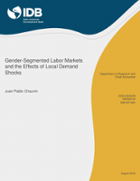Gender-Segmented Labor Markets and the Effects of Local Demand Shocks
Date
Aug 2018
Gender segmentation in the labor market is widespread. However, most existing studies of the effects of labor demand shocks on local economies assume away gender. In this paper, I show that local labor demand shocks can lead to different outcomes depending on whether they favor male or female employment. I develop a spatial equilibrium model that features gender segmented labor markets and joint mobility frictions, which predicts that couples are more likely to migrate in response to male opportunities. As a result, positive shocks to local labor demand for men lead to population growth, increases in female labor supply, and housing demand growth. Meanwhile, equivalent shocks to labor demand for women lead to smaller inflows of migrant workers, and labor force participation is a relatively more important margin of adjustment in this case. I find strong empirical support for the model’s predictions in the context of Brazil during 1991-2010. Comparing the effects of gender-specific labor demand shocks, I show that male shocks produce a higher migratory response and make localities more populated and expensive. These results imply that place-making policies that create jobs for females are more likely to benefit residents while those that create male jobs are more likely to benefit immigrants and landlords.




